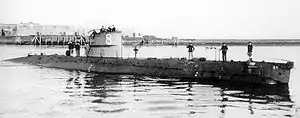 HNLMS O 8 | |
| History | |
|---|---|
| Name | HMS H6 |
| Builder | Canadian Vickers, Montreal |
| Laid down | 1914[1] |
| Launched | 12 May 1915[1] |
| Commissioned | 10 June 1915[1] |
| Fate | Sold to the Netherlands on 4 May 1917 |
| Name | HNLMS O 8 |
| Acquired | 4 May 1917[2] |
| Commissioned | 7 May 1917[3] |
| Fate | Scuttled by Dutch forces following German invasion of the Netherlands during Second World War. Later refloated by Germany on 14 May 1940 |
| Name | UD-1 |
| Commissioned | 21 November 1940[1] |
| Decommissioned | 23 November 1943[1] |
| Fate | Scuttled in Kiel Harbour following Allied advance on 3 May 1945[1] |
| General characteristics (as built) | |
| Class and type | H-class submarine |
| Displacement |
|
| Length | 150 ft 3 in (45.80 m) |
| Beam | 15 ft 4 in (4.67 m) |
| Propulsion |
|
| Speed |
|
| Range |
|
| Complement | 22 |
| Armament |
|
| Service record as UD-1[1] | |
| Part of: |
|
| Commanders: | |
| Operations: | None |
| Victories: | None |
HMS H6 was a British H-class submarine of the Royal Navy built by Canadian Vickers & Co. during World War I.
History
She was completed on 10 June 1915 and was commissioned by the Royal Navy the same year. However, her service in the Royal Navy was short. On 19 January 1916, she ran aground near the Dutch island of Schiermonnikoog, after which she was interned by the Royal Netherlands Navy. On 4 May 1917, an agreement was reached to sell H6 to the Netherlands.
Dutch service
The Royal Netherlands Navy renamed H6 to HNLMS O 8 and refitted her, with knowledge gained from the interned German submarine UC-8. After UC-8 was bought from Germany O 8 was equipped with UC-8's Zeiss periscope. During maintenance in October 1921, O 8 partly sank in the harbour at Den Helder.[2] Because only minor damage was sustained, she was repaired and continued in service. In the summer of 1925, O 8 together with the other Dutch vessels HNLMS K XI, HNLMS Jacob van Heemskerck, HNLMS Marten Harpertszoon Tromp, HNLMS Z 3 and HNLMS Z 5 were part of an exercise in the Baltic Sea.
During the German attack on the Netherlands at the start of the Second World War, O 8 was still in Dutch service. At the time she was undergoing maintenance and as a result could not escape during the invasion.[9] Instead it was decided to scuttle her.[10]
German service
After the surrender of the Netherlands, the German forces were able raise O 8 and found her almost fully intact.[11]
Germany took O 8 into service as UD-1 and transferred her from Den Helder to Kiel. In Kiel, she was used as training ship to train crews for the German U-boats. Because of her age, she was decommissioned on 23 November 1943. On 3 May 1945, she was scuttled again in the harbour at Kiel.[12]
References
- 1 2 3 4 5 6 7 Helgason, Guðmundur. "Foreign U-boats UD-1". German U-boats of WWII - uboat.net. Retrieved 30 April 2015.
- 1 2 Jalhay (1982), p. 107.
- ↑ von Münching (1978), p. 33.
- ↑ Helgason, Guðmundur. "Hermann Rigele". Uboat.net. Retrieved 30 April 2016.
- ↑ Helgason, Guðmundur. "Friedrich Schäfer". Uboat.net. Retrieved 30 April 2016.
- ↑ Helgason, Guðmundur. "Franz Venier". Uboat.net. Retrieved 30 April 2016.
- ↑ Helgason, Guðmundur. "Wolfgang Ketelsen". Uboat.net. Retrieved 30 April 2016.
- ↑ Helgason, Guðmundur. "Friedrich Weidner". Uboat.net. Retrieved 30 April 2016.
- ↑ de Bles, Boven and Homburg (2006), p. 95.
- ↑ Jalhay (1982), p. 29.
- ↑ Bezemer, K.W.L.; Zij vochten op de zeven zeeën; Uitgeversmaatschappij W. de Haan N.V.; 1954
- ↑ Dutchsubmarines.com O 8
Bibliography
- Busch, Rainer; Röll, Hans-Joachim (1999). German U-boat commanders of World War II : a biographical dictionary. Translated by Brooks, Geoffrey. London, Annapolis, Md: Greenhill Books, Naval Institute Press. ISBN 1-55750-186-6.
- Busch, Rainer; Röll, Hans-Joachim (1999). Deutsche U-Boot-Verluste von September 1939 bis Mai 1945 [German U-boat losses from September 1939 to May 1945]. Der U-Boot-Krieg (in German). Vol. IV. Hamburg, Berlin, Bonn: Mittler. ISBN 3-8132-0514-2.
- Gröner, Erich; Jung, Dieter; Maass, Martin (1991). German Warships 1815–1945, U-boats and Mine Warfare Vessels. Vol. 2. Translated by Thomas, Keith; Magowan, Rachel. London: Conway Maritime Press. ISBN 0-85177-593-4.
- Jalhay, P.C.; Wijn, J.J.A. (1997). Ik nader ongezien! De onderzeeboten van de Koninklijke Marine. Amsterdam: De Bataafsche Leeuw. ISBN 9067074624.
- von Münching, L.L. (1978). Schepen van de Koninklijke Marine in de Tweede Wereldoorlog (in Dutch). Alkmaar: De Alk. ISBN 90-6013-903-8.
- de Bles, Harry; Boven, Graddy; Homburg, Leon (2006). Onderzeeboten! (in Dutch). Zaltbommel: Aprilis. ISBN 978-90-5994-130-4.
- Jalhay, P.C. (1982). Nederlandse Onderzeedienst 75 jaar (in Dutch). Bussum: De Boer Maritiem. ISBN 90-228-1864-0.
External links
- 'Submarine losses 1904 to present day' - Royal Navy Submarine Museum Archived 25 September 2015 at the Wayback Machine